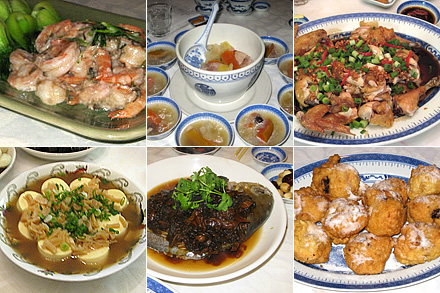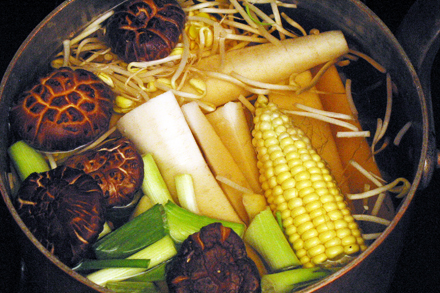
I’m sure you’re very familiar with the hanging chickens and ducks in many Chinatown “charcuterie,” where you can get various kinds of roast meat and sausages. You are also probably familiar with how the shopkeeper hacks the chicken or duck with monstrous cleaver into bite-size pieces, unlike the common practice of cutting poultry at the joints by Western chefs. At a recent dinner party for a few newfound friends, I cooked a crispy chicken and was happily wielding my somewhat smaller cleaver when I missed and hit a beautiful celadon platter sitting next to the chopping board. Warren and I brought this peony-patterned platter back from Thailand fifteen years ago. The platter was crushed and so was I.

However my dinner guests were very sympathetic as many of them earn their living in the food industry, so they’ve all experienced similar accidents. Simpson Wong, who owns Café Asean in New York City’s Greenwich Village brought his partner, Henry. Wendy Chan, the president and founder of Definity Marketing and creator of a web site New Asian Cuisine, was accompanied by her husband, David. Scott Barton, a chef and culinary consultant, brought along his girlfriend, Michele.
I designed the menu hoping to spark a conversation about authentic regional Chinese cooking. I included some dishes that are not well known in America. In particular the following rare dishes: stir-fried shrimp with Longjing tea (龍井蝦仁), steamed pomfret with preserved cabbage (梅菜蒸鯧魚), steamed silken tofu in dried scallop sauce (干貝水豆腐), and papaya and white fungus soup (銀耳木瓜湯). I also served a quartet of cold dishes, which are often neglected in Chinese restaurants in America but are quite necessary in a Chinese meal. The cold dishes include tofu and preserved egg in a chili sauce (辣拌皮蛋豆腐), sweet and sour watermelon radish salad (糖醋蘿蔔絲), cucumber salad with garlic (涼拌黃瓜), and jellyfish in sesame dressing (涼拌海蜇絲). To balance out the meal I incorporated some of my standard fare such as red cooked pork (紅燒肉), crispy chicken with garlic sauce (蒜香油淋雞), spinach in chicken stock with garlic (上湯菠菜), dried shrimp fried rice (蝦米炒飯), and deep fried red bean paste in meringue (高力豆沙) for dessert.

The menu certainly had the intended effect. We had a very lively conversation about Chinese food. Simpson made an interesting observation that my menu included a wide variety of cooking techniques. We all lamented that most Chinese restaurants mainly stir-fry. This limits the menu offerings, as well as the American public’s exposure to a wide variety of Chinese food. I believe this is because many Chinese restaurants cater to a “fast food” audience. Concentrating the menu to stir-frying puts less demand on the kitchen.
Wendy noted that texture is a big deterrent for American’s appreciation of Chinese delicacies. What with jelly like sea cucumbers, crispy jellyfish, chewy fungus and many other exotic ingredients, it is not easy for non-Chinese palates to adjust.
Scott felt that these initial negative reactions could be overcome by continued exposure. As a young boy, he remembers his first encounter with Indian food. Along with the initial negative shock he remembers that it did peak his curiosity about other cuisines.
At the end of the meal we all felt that exposure to a cuisine is the most important factor in its appreciation. Many young Americans returning from China after stints of work, or vacationing are beginning to seek the authentic Chinese cooking they encounter there. As demand increases I believe it is possible to introduce more authentic Chinese cooking to the American public. I hope my blog can offer more access to authentic Chinese cooking.
For now though I’m very excited to have gained such wonderful, supportive new “foodie” friends and to only have lost a platter.






We are two of the few lucky guests fortunate enough to have been invited by Kian to his Spring Chinese dinner gathering. Not until we got there did we realize that it was going to be a sumptuous multi-course feast. We started off with some cold tapas that have very interesting contrasting textures and flavors enlivening our palate. This was followed by a course of appetizers including a dish of red cook meat with steamed buns that was perfectly braised and seasoned. Next come a palate cleanser of Papaya and White Fungus soup, very unusual. The array of entrees that following included our favorite which was the juicy garlic chicken. In the end, what amazed us is the wide spectrum of flavors and cooking techniques that could be made from a home kitchen by a single person. This is a far cry from the generic soy sauce drenched dishes one get from a presumably “authentic” Chinese restaurant here in New York City. Thanks for inspiring us, Kian!
this is great, Kian. Beautiful post, and a wonderful addendum to a great meal!
peace, S
I, too, am amazed by how professional Chinese chefs wield a cleaver, chopping up an entire chicken in less time than it takes for me to eat a single piece. It’s a shame about your platter. The food looks amazing, though!
Love your blog, Kian–only discovered it a few weeks ago. But I grew up on “Chinese” food (even in darkest Michigan!), although it wasn’t until Buwei Yang Chao’s delightful book came our way that we started doing it more or less right. (So glad you gave her credit for the term “stir-fry,” although I’ve heard it was probably her husband the famous linguist that actually made it up.)
Please keep the real stuff coming! I do only one dish with silken doufu and would love to learn more–the texture is so novel and so lovely. Maybe I’ll get brave and try sea cucumber. Just have to try not to remember what it really is.
Betsy,
I’m so glad to hear you are enjoying Red Cook.
You’re right that the term “stir-fry” was coined by Buwei Yang Chao’s husband. The term was used for the first time in her book, How to Cook and Eat in Chinese, and that was where it found its fame. The rest is history.